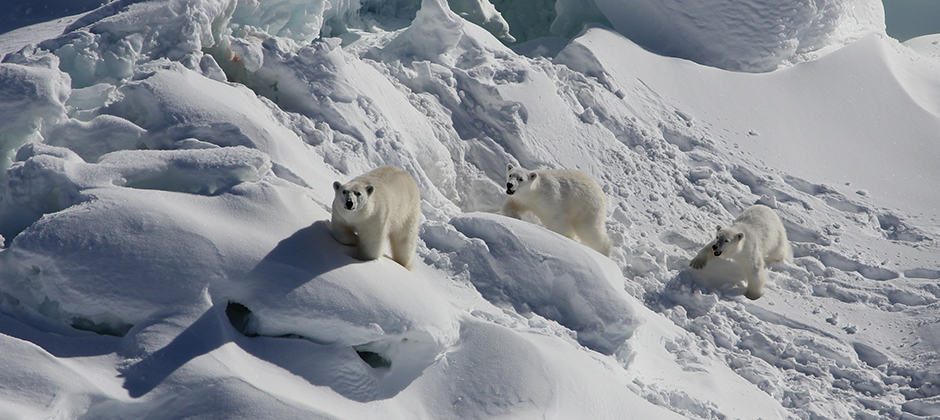Share this article
Isolated polar bear population endures, even when sea ice is gone
In a remote corner of southeastern Greenland, researchers discovered an isolated, genetically distinct polar bear population that survives in a landscape without sea ice for most of the year—the sort of climate conditions that scientists think will prevail in the Arctic by the end of the century. The discovery offers hope that at least some polar bears—occupying isolated pockets with similar habitat conditions—can cope with the melting sea ice brought on by climate change.
“I think these bears can shed some light on species persistence,” said Kristin Laidre, a scientist at the Polar Science Center at the University of Washington and lead author on the recent study published in Science. “This type of habitat might support some small numbers of polar bears as we lose sea ice.”
Polar bears (Ursus maritimus) typically rely on sea ice to hunt seals. As these stretches of ice melt in warming temperatures, polar bear numbers throughout the Arctic are declining. The bears that Laidre’s team studied only have access to sea ice for about 100 days a year. Less severe conditions elsewhere have caused polar bear populations to tumble.
But these bears have something most polar bears don’t. When the sea ice is gone, they still have freshwater glacial ice, where they can still find the same seals. It is a “unique habitat,” Laidre said, available only in a few places on earth—parts of Greenland, Norway and northern Canada. But most polar bears will never see it.
“We project large declines of polar bears across the Arctic, and this study doesn’t change that,” she said.
It does, however, uncover a unique population below the Arctic Circle that is surviving in a way that researchers had never seen before, and it hints at ways fragmented polar bear populations may endure climate change.
Without sea ice, the bears of southeastern Greenland hunt on the glacial mélange—the shifting mix of unconsolidated ice calving off the front of marine-terminating glaciers that come off the Greenland Ice Sheet. That behavior makes them unusual. Genetic analysis showed they are unique—isolated from all other 19 polar bear populations in the Arctic. The authors propose that Southeast Greenland bears be considered the 20th subpopulation of polar bears in the Arctic.
“It was a completely unexpected finding,” Laidre said.
Laidre and her team had set out to better understand polar bears across 1,800 miles of the eastern Greenland coastline, including the fjords of southeastern Greenland. Their work was part of a decade-long survey—observing, capturing and collecting tissue samples from the bears—to provide scientific advice to the government of Greenland in setting hunting quotas for subsistence hunters. Before starting the fieldwork, the team spent two years speaking with subsistence hunters, and the hunters participated throughout the study, contributing expertise and providing harvest samples for genetic analysis.
In the remote, sparsely populated landscape of southeastern Greenland, the researchers thought polar bear density would be sparse, too, but that wasn’t what they found.
“As we flew around, I was struck by how many bears we were seeing in these fjords,” Laidre said.
But the bears seemed “stuck” in place, she said, forced by the lack of offshore sea ice to climb into the mountains to reach neighboring fjords.
Laidre’s team put satellite collars on female bears to track their movement and took tissue samples to understand their genetics. They compared what they found with data from bears throughout the region. The bears have very local movements, they found, residing in the same fjord or neighboring fjords for years.
“It was really that moment that we got the data back from the genetics lab that I was really shocked,” Laidre said. “The polar bears in southeast Greenland are the most isolated polar bears on the planet.”
Genetically, they have been separated from other polar bear populations by hundreds of years. Adult females are smaller than most bears, and cubs seemed to be few. While population studies are still needed, Laidre said, the observations suggest that while the bears are persisting, the conditions around them might be less than optimal. Laidre believes that monitoring these bears could help biologists learn a lot about how pockets of polar bears might survive in a warming world.
“Unless we have global action on climate change,” she said, “we are looking at a future where polar bears are fragmented in small populations and in habitats where they can hang on.”
Header Image: An adult female polar bear and two year-old cubs walk over snow-covered freshwater glacier ice in southeastern Greenland in March 2015. Credit: Kristin Laidre








